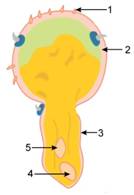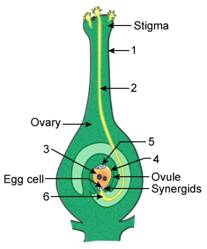Selina ICSE Solutions for Class 9 Biology Chapter 5 - Pollination and Fertilization
Exercise 1
A. Multiple Choice Type.
1. Which one of the following is one of the characteristics of self-pollinated flowers?
(a) Flowers are large and showy
(b) Flowers remain closed and do not open
(c) Stigma and anthers mature at the same time
(d) Pollen is produced in very large quantities
2. Exine and intine are the parts of
(a) Embryo sac
(b) Pollen grain
(c) Stigma
(d) Seed
Solution A.
1. (c) Stigma and anthers mature at the same time
2. (b) Pollen grain
B. Very Short Answer Type.
1. Match the items in Column A with those in Column B.
Column A
|
Column B
|
(a) Generative nucleus
|
(i) Pollen tube
|
(b) Germ pore
|
(ii) Endosperm nucleus
|
(c) Exine
|
(iii) Testa
|
(d) Secondary nucleus
|
(iv) Fertilization
|
(e) Integument
|
(v) Male nuclei
|
(f) Egg nucleus
|
(vi) Rough
|
Solution B.1.
2. State the name of the chief pollinating agent against the corresponding plant by choosing from those given in brackets.
(a) Dahlia_______ (crow, butterflies, mosquito).
(b) Maize_______ (bees, locusts, rain, wind)
(c) Vallisneria _______ (wind, water, ants, rabbits).
(c) Vallisneria _______ (wind, water, ants, rabbits).
Solution B.2.
(a) butterflies
(b) wind
(c) water
3. Fill in the blanks with suitable words.
(a) Transference of pollen grains from anthers to stigma of the same flower is called ________.
(b) Different timings for maturation of gynoecium and androecium is called ________.
(c) _______ is a water-pollinated flower.
Solution B.3
.
(a) autogamy
(b) dichogamy
(c) Vallisneria
4. Name of the parts of the ovary which give rise to:
(a) Seed ______
(b) Fruit ______
(c) Fruit wall ______
Solution B.4.
(a) Ovules
(b) Ovary
(c) Ovarian wall
5. Give one word/term for the following:
(a) A flower containing both male and female parts.
(b) Arrangement of flowers on a twig/stem.
(c) When pollen grains of a flower reach the stigma of the same flower.
(d) When maturation time of reproductive parts in a flower is different.
(e) When stigma and anthers do not grow up to same height, which favours only cross pollination.
(f) Pollination of flowers by insects.
(g) Pollination of flowers by birds.
Solution B.5.
(a) Bisexual flower
(b) Inflorescence
(c) Self-pollination/Autogamy
(d) Dichogamy
(e) Heterostyly
(f) Entomophily
(g) Ornithophily
C. Short Answer type.
1. Explain the following terms:
(a) Ornithophily
(b) Elephophily
(c) Artificial pollination
Solution C.1.
(a) Ornithophily-Pollination affected by birds
(b) Elephophily-Pollination affected by elephants
(c) Artificial pollination-Pollination affected by man through artificial means
2. What happens to the following after fertilization?
(a) Ovules
(b) Calyx
(c) Petals
(d) Stamens
Solution C.2.
(a) Ovules-Seed
(b)Calyx-Falls off or remains intact in dried and shrivelled form
(c) Petals-Fall off
(d) Stamens-Fall off
3. Mention any two contrivances in flowers which favour cross-pollination.
Solution C.3.
Contrivances in flowers which favour cross-pollination:
1. Unisexuality
2. Different timings of maturation ofandroeciumand gynoecium
3. Self-sterility
4. Structural barriers
D. Long Answer Type.
1. What are the advantages of the following in the flower to the plant concerned?
(a) Long and feathery stigma
(b) Brightly coloured petals
(c) Smooth and light pollen
(d) Protruding and easily movable anthers
(d) Protruding and easily movable anthers
(e) Fragrant nectar
Solution D.1.
(a) Long and feathery stigma: Help to trap pollen grains in wind-pollination
(b) Brightly coloured petals: Attracting insects for cross-pollination
(c) Smooth and light pollen: Easily carried by wind to enable cross-pollination
(d) Protruding and easily movable anthers: Even slightest wind can move them
(d) Protruding and easily movable anthers: Even slightest wind can move them
(e) Fragrant nectar: Attracting insects for pollination
2.Describe the advantages and disadvantages of cross-pollination to the plant.
Solution D.2.
Advantages of cross-pollination:
1. The offspring are healthier.
2. The seeds produced are abundant and viable.
3. New varieties may be produced by cross-pollinating two different varieties of the same species.
Disadvantages of cross-pollination:
1. Pollination is not always certain.
2. The pollen has to be produced in large quantity.
3. The process is uneconomical for the plant because the flowers have to be large,coloured, scented and have to produce nectar for attracting pollinating agents.
E. Skill Type
1. What is the function of the pollen tube? Explain it with the help of a diagram.
Solution E.1.
The pollen tube grows out of the pollen grains by breaking through its exine. The pollen tube grows through the stigma and style by dissolving these tissues with the help of enzymes and reaches the ovary, where it enters the ovule through a minute pore called the micropyle.
2. Given ahead is a diagrammatic sketch of the sectional view of a germinating pollen grain. Study the same and then answer the questions that follow:

(a) Name the parts labelled 1, 2, 3, 4 and 5.
(b) Where does the germination of the pollen grain take place and how?
(c) What is the function of the part labelled '4'?
(d) What happens to the part labelled '5' during the process?
Solution E.2.
(a)
1 → Exine
2 → Intine
3 → Pollen tube
4 → Tube nucleus
5 → Generative nucleus
(b) Germination of the pollen grain takes place only after it falls on the stigma of the same plant species. The pollen grain is stimulated to germinate due to the secretion of sugars by the stigma.
(c) The function of part ‘4’ (tube nucleus) is to direct the growth of the pollen tube towards the ovary.
(d) During germination of the pollen grain, part ‘5’ (generative nucleus) present at the tip of the pollen tube divides into two sperm nuclei. The pollen tube enters one of the synergids and releases its two sperm nuclei. Of these, one sperm nucleus enters the egg cell and fuses with its nucleus, while the other sperm nucleus moves towards the two polar nuclei in the central cell and fuses with them.
3. Given ahead is a diagrammatic representation of the process of fertilisation. Study the same and then answer the questions that follow:

(a) Name the parts labelled 1, 2, 3, 4, 5 and 6.
(b) What happens to
(i) Ovary
(ii) Ovule after fertilisation
(c) What is the function of the synergids?
(d) What part does the stigma play in the process of fertilisation?
Solution E.3.
(a)
1 → Style
2 → Pollen tube
3 → Polar nuclei
4 → Embryo sac
5 → Antipodal cells
6 → Micropyle
(b) After fertilisation
(i) The ovary enlarges to form the fruit and the ovarian wall forms the fruit wall.
(ii) The ovule becomes the seed.
(c) Synergids help in nourishing the egg cell, guiding the pollen tube towards the egg, proper functioning of the pollen tube and release of sperm nuclei.
(d) Pollen grain is transferred to the stigma during pollination. Germination of pollen grain takes place only if it falls on the stigma. After germination, the pollen tube grows through the stigma and reaches the ovary for the fertilisation of the egg cell.
Selina ICSE Solutions for Class 9 Biology Chapter 5 - Pollination and Fertilization

